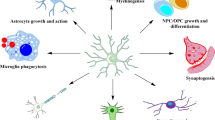Abstract
Microglia are important resident immune cells in the central nervous system (CNS) and involved in the neuroinflammation caused by CNS disorders, including brain trauma, ischemia, stroke, infections, inflammation, and neurodegenerative diseases. Our study explores the hypothesis that conserved dopamine neurotrophic factor (CDNF), a secretory neurotrophic factor, may provide a novel therapy for associated with neuroinflammation related to the microglia. We observed that CDNF was upregulated in rat primary microglia treated with 1 μg/mL lipopolysaccharide, an inflammatory inducer, for 24 h. Thus, we hypothesize that CDNF may play a role, mediator or inhibitor, in regulating the inflammation in microglial cells induced by LPS. Finally, our data showed that CDNF significantly attenuated the production of proinflammatory cytokines (PGE2 and IL-1β) and remarkably alleviated the cytotoxicity (percentage of lactate dehydrogenase released) in the LPS-induced microglia by suppressing the phosphorylation of JNK, but not the P38 or ERK pathways. These results demonstrate the anti-inflammatory property of CDNF by inhibition of JNK signaling in LPS-induced microglia, suggesting that CDNF may be a potential novel agent for the treatment of neuroinflammation in the CNS disorders.





Similar content being viewed by others
References
Airavaara M, Shen H et al (2009) Mesencephalic astrocyte-derived neurotrophic factor reduces ischemic brain injury and promotes behavioral recovery in rats. J Comp Neurol 515(1):116–124
Bruhn H (2005) A short guided tour through functional and structural features of saposin-like proteins. Biochem J 389(Pt 2):249–257
Cheng L, Zhao H et al (2013) Overexpression of conserved dopamine neurotrophic factor (CDNF) in astrocytes alleviates endoplasmic reticulum stress-induced cell damage and inflammatory cytokine secretion. Biochem Biophys Res Commun 435(1):34–39
Ip YT, Davis RJ (1998) Signal transduction by the c-Jun N-terminal kinase (JNK)–from inflammation to development. Curr Opin Cell Biol 10(2):205–219
Johnston H, Boutin H et al (2011) Assessing the contribution of inflammation in models of Alzheimer's disease. Biochem Soc Trans 39(4):886–890
Kaminska B (2005) MAPK signalling pathways as molecular targets for anti-inflammatory therapy–from molecular mechanisms to therapeutic benefits. Biochim Biophys Acta 1754(1–2):253–262
Khandelwal PJ, Herman AM et al (2011) Inflammation in the early stages of neurodegenerative pathology. J Neuroimmunol 238(1–2):1–11
Kim WG, Mohney RP et al (2000) Regional difference in susceptibility to lipopolysaccharide-induced neurotoxicity in the rat brain: role of microglia. J Neurosci 20(16):6309–6316
Kreutzberg GW (1996) Microglia: a sensor for pathological events in the CNS. Trends Neurosci 19(8):312–318
Kwiatkoski M, Soriano RN et al (2013) Hydrogen sulfide inhibits preoptic prostaglandin E2 production during endotoxemia. Exp Neurol 240:88–95
Lindholm P, Saarma M (2010) Novel CDNF/MANF family of neurotrophic factors. Dev Neurobiol 70(5):360–371
Lindholm P, Voutilainen MH et al (2007) Novel neurotrophic factor CDNF protects and rescues midbrain dopamine neurons in vivo. Nature 448(7149):73–77
Messmer K, Reynolds GP (2005) An in vitro model of inflammatory neurodegeneration and its neuroprotection. Neurosci Lett 388(1):39–44
Parkash V, Lindholm P et al (2009) The structure of the conserved neurotrophic factors MANF and CDNF explains why they are bifunctional. Protein Eng Des Sel 22(4):233–241
Rousseau MC, Hsu RY et al (2013) Lipopolysaccharide-induced toll-like receptor 4 signaling enhances the migratory ability of human esophageal cancer cells in a selectin-dependent manner. Surgery 154(1):69–77
Schuh K, Pahl A (2009) Inhibition of the MAP kinase ERK protects from lipopolysaccharide-induced lung injury. Biochem Pharmacol 77(12):1827–1834
Song GY, Chung CS et al (2001) MAPK p38 antagonism as a novel method of inhibiting lymphoid immune suppression in polymicrobial sepsis. Am J Physiol Cell Physiol 281(2):C662–C669
Sugama S (2009) Stress-induced microglial activation may facilitate the progression of neurodegenerative disorders. Med Hypotheses 73(6):1031–1034
Takakuwa T, Endo S et al (1994) PAF acetylhydrolase and arachidonic acid metabolite levels in patients with sepsis. Res Commun Chem Pathol Pharmacol 84(3):283–290
Voutilainen MH, Back S et al (2009) Mesencephalic astrocyte-derived neurotrophic factor is neurorestorative in rat model of Parkinson's disease. J Neurosci 29(30):9651–9659
Xie Z, Smith CJ et al (2004) Activated glia induce neuron death via MAP kinase signaling pathways involving JNK and p38. Glia 45(2):170–179
Zhao H, Liu Y, et al. (2013). "Mesencephalic astrocyte-derived neurotrophic factor inhibits oxygen-glucose deprivation-induced cell damage and inflammation by suppressing endoplasmic reticulum stress in rat primary astrocytes." J Mol Neurosci
Zindler E, Zipp F (2010) Neuronal injury in chronic CNS inflammation. Best Pract Res Clin Anaesthesiol 24(4):551–562
Acknowledgments
The authors are grateful to Prof. Chen ZY, Department of Neurobiology, Shandong University, for their kind advice and help with this research.
Grants
The study was supported by the grant from Ph.D. Programs Foundation of Ministry of Education of China (20110131120079).
Author information
Authors and Affiliations
Corresponding authors
Additional information
Hua Zhao and Lei Cheng contributed equally to this study.
Rights and permissions
About this article
Cite this article
Zhao, H., Cheng, L., Liu, Y. et al. Mechanisms of Anti-inflammatory Property of Conserved Dopamine Neurotrophic Factor: Inhibition of JNK Signaling in Lipopolysaccharide-Induced Microglia. J Mol Neurosci 52, 186–192 (2014). https://doi.org/10.1007/s12031-013-0120-7
Received:
Accepted:
Published:
Issue Date:
DOI: https://doi.org/10.1007/s12031-013-0120-7




